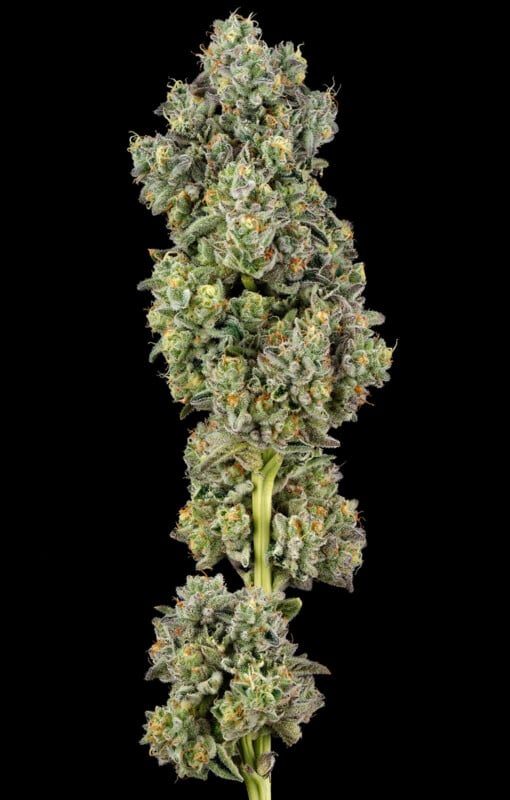Meet the Photographer Carving out a Niche in Cannabis

Markets come and go and budgets rise and fall, but one trade has been set alight in the United States in the last decade or so — the cannabis industry.
As state legislation of the federally prohibited drug has liberalized, legitimate companies have moved into selling weed. And where there are products to be sold, photography is needed.
Greg Malcolm recognized this niche in 2017 when he set up Maryland Connoisseur Studio, a photographic business that specializes in marijuana.
“There was quite a ‘green rush’ at first with many people trying to get into the new cannabis business sphere and at the same time the cannabis companies themselves had little to no experience in marketing, social media, and content creation,” Malcolm tells PetaPixel.
![]()
Malcolm says that after an initial “Wild West” period when influencers were sought after for their social media followings. Creative professionals, like Malcolm, have been able to benefit from the legal cannabis business.
How Does it Work?
Malcolm regularly posts stunning macro photos of various weed strains to his Twitter feed, accentuating the different colors and crystals found in the plant’s variants.
“Everything is above board to an absurd extent sometimes, especially in terms of shooting in a large cannabis processing facilities,” explains Malcolm.
“[It] starts with security check-in, changing into lab suits, that includes coverings on your feet, head, beard, hands, etc. Going through secondary checks of bags and gear etc.”
![]()
![]()
Aside from the intense security, there is a unique photographic challenge when shooting in a large cultivation facility that contains wildly different environments.
“I’ll be set up in a room that is lit by high-pressure sodium lights (orange), some will be lit by multi-spectrum LEDs and then some are lit by blue lights for vegetative growth so you have to be very aware of the lighting challenges in terms of color balancing, etc,” says Malcolm.
“There are powerful HVAC units that make getting macro shots difficult, one room will be cool with no humidity then the next will be hot and very humid. Your glasses including your filter and lenses need to be wiped down repeatedly.”
If Malcolm wants to take a product back to his studio so he can photograph it, he’s not allowed to take it straight from the factories that don’t sell directly to customers.
“I get in these situations where I am surrounded by cannabis literally wall to wall but then I’ll need to drive miles to a retail dispensary in order to actually procure it for a photo session back at my studio,” he adds.
Waiting for the Harvest
Much of Malcolm’s work is product photography, including macro shots of the plant. But he is beholden to the cycle of crop gathering.
“[It] is dictated by the harvest dates,” he says. “The drying, curing, finishing, and trimming times. Then it has to be wholesaled and transported.”
![]()
![]()
“The cultivation sites are like green factories where the inputs are grown organically rather than being delivered from somewhere else.
“They work in this incredible circadian rhythm that starts with seed/clones/tissue, moves to rapid spring-like vegetative growth, then into a 12/12 hour orange HPS light cycle that mimics the fall sun triggering bud growth and harvest time. Then the fruit is harvested with care and the whole cycle begins again.”
Harvesting time is Malcolm’s busiest period because it’s when his clients need imagery of their products that are about to hit the shops.
![]()
A Growing Market
While Malcolm only knows of one other photo studio like his in Maryland, he believes that the creative cannabis market has a lot more growing to do.
“We are just in the beginning stages,” he says. “As the market develops and businesses have larger budgets, there will be greater legal means to reach more people by way of mainstream advertising. Commercial studios like mine will move up the value chain.
“In other words when these companies can start to advertise to a much larger legal market the entire ecosystem will benefit.
“Federal cannabis reform is really what should happen soon, then we’ll have a national market as opposed to the state-by-state system as it currently is.”
![]()
Camera Gear
Malcolm, who started out as a skateboard and music photographer before moving into marijuana, uses a Sony a7 IV for stills and a Sony a7S III for video.
“My main lenses are a Sony 90mm Prime f2.8 Macro G OSS, Loawa 100mm Prime f2.8 2x Macro Lens,” he says.
“The Sony 90mm Macro is my bread and butter lens, great for macro, product, and portraits, the texture it produces is quite nice. The Laowa 100mm Macro lens is fully manual and I use this lens primarily for focus stacking. The image it produces is super-tack sharp.”
More of Malcolm’s work can be found on his website, Instagram, and Twitter.
Image credits: All photos by Greg Malcolm/Maryland Connoisseur Studio.